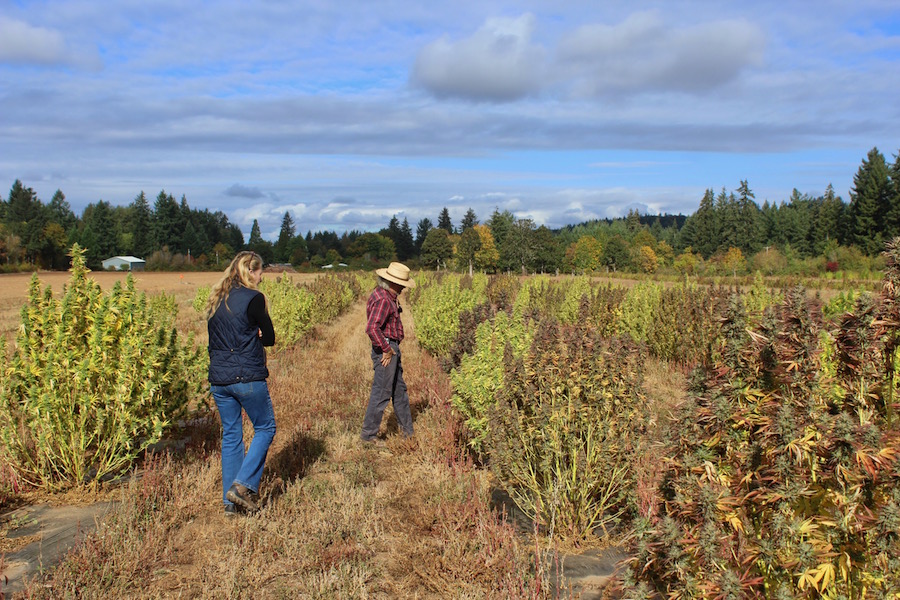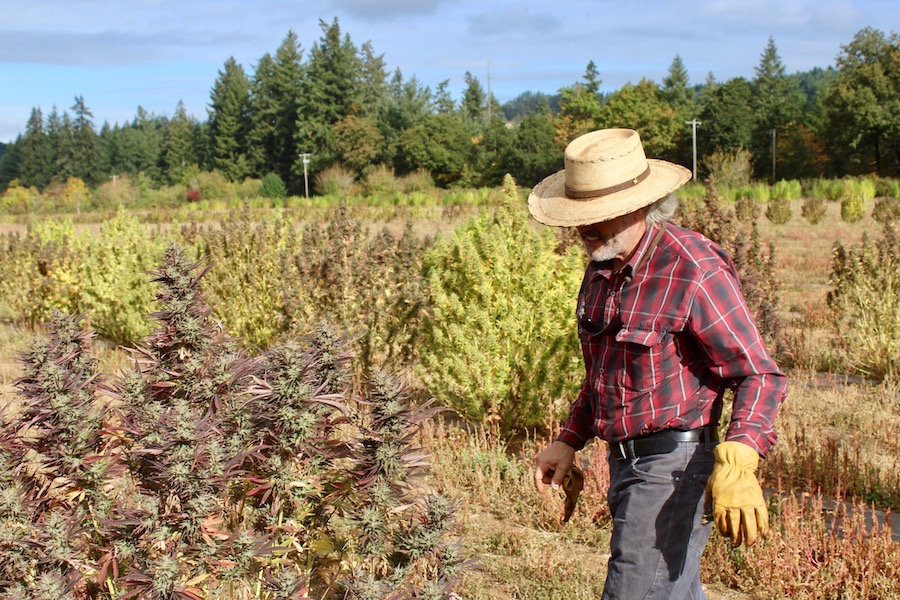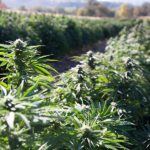Permits more than doubled over the past year.
Sipping a tea brewed from peppermint, licorice root and cannabidiol extract, Rochelle Koch and her husband Peter gaze proudly at their 90-acre hemp farm, Whole Circle Farms, nestled in the foothills of the Willamette Valley. In the fields, part-time high school students harvest indigo and green buds and dry them in wood-framed beds in a barn.
The pastoral scene belies the turbulent world in which the Kochs do business, one defined by outdated regulations, public misconceptions and increasing competition—but also by considerable opportunity.
The Oregon hemp industry is like a raging river, restrained by a dam that might soon break and allow products to flood an array of new markets. A provision in the 2018 Farm Bill before Congress would strike cannabidiol from the Drug Enforcement Administration’s list of Schedule 1 drugs, those the agency deems to have the highest potential for abuse.
 Although the two plants appear similar, hemp provides none of the psychoactive effects of recreation cannabis.
Although the two plants appear similar, hemp provides none of the psychoactive effects of recreation cannabis.
The change could clear the way for Oregon hemp to appear on Amazon and eBay, invite capital investment and unlock international markets. Portland-based lobbyist and lawyer Courtney Moran, who helped draft the language of the provision, says it’s “providing the full, clear legal authority for industrial hemp in the U.S.”
“No. 1, it’s going to loosen up banking opportunity,” says Barry Cook, a hemp farmer in Boring. “Right now we’ve got a banking industry that’s a little bit wiggy when it comes to hemp.”
The new legislation, currently mired in partisan debate, would dramatically expand an already booming market. Over the past year, Oregon more than doubled its hemp production. Licenses to grow hemp, according to the Department of Agriculture, increased from 230 in 2017 to 560 in 2018.
Acres of farmland occupied by the plant more than tripled, from 3,000 to 11,000. The agency added temp workers to handle the overflow.
“We’ve seen explosive growth,” says Gary McAninch, the agency’s industrial hemp program manager. “We’re scrambling on our end to get our work done.”
Nationally, hemp sales topped $820 million in 2017. The market is expected to reach $1 billion in 2018.
In the roller-coaster cannabis industry, hemp enjoys a smoother ride than recreational marijuana. Oregon marijuana growers have produced heaping piles of weed far in excess of what consumers can smoke and ingest. Federal law prohibits growers from shipping outside the state, restricting demand in the legal market. Many growers are now fleeing to the more promising hemp trade.
Discouraged marijuana growers don’t tell the whole story behind hemp’s recent growth. Oregon allows non-residents to obtain hemp permits, and a steady stream of farmers are migrating north from the illegal market in California. Others are entering the market with no growing experience to capitalize on health-products trends, the Kochs say, and the success consumers have experienced with pain relief.

Peter Koch, co-owner of Whole Circle Farms.
Yet the hemp market is no modern-day California gold rush. “Everybody thinks they’re going to be a millionaire overnight,” Peter Koch says, “but the millionaires have already come and gone.”
Bankers deny loans, fearing hemp poses as much risk as marijuana. Credit card companies aren’t interested either. Facebook scrubs hemp ads, and Amazon and eBay remove hemp-based products. Adam Kurtz, founder of Oregon Fusion, a network of seven Oregon hemp farms, says dealing in hemp feels “like operating a business in quicksand.”
Peter Koch says consumers still associate hemp with their negative stereotypes about marijuana. He says, “People buy and don’t want anyone to know.”

Hemp dries in the Kochs’ barn.
In fact, hemp produces none of marijuana’s psychoactive effects. It’s strictly monitored to contain less than .3 tetrahydrocannabinol (THC), the compound in marijuana that produces a high.
The hemp plant can’t get you high, but it does soothe aches, offer better durability than cotton in clothing and revitalize radioactive soils. An experiment in the 1990s demonstrated that hemp could accumulate heavy metals from contaminated fields near Chernobyl.
State agencies are catching on. A new fee structure under review at the Department of Agriculture would ease the financial burden of licenses for small farmers. Other changes passed this spring make it easier to access information at the Oregon Liquor Control Commission, the Oregon Health Authority and the Department of Agriculture, the three state agencies that regulate the crop.
As is true of many policy battles under the Trump administration, Oregon regulators find themselves at odds with their federal counterparts.
“I think we have a very solid program here we’ve worked hard to develop,” Moran says. “I think a lot of the issue is guidance coming from federal agencies that’s inconsistent with the letter of the law.”
Stringent testing standards, farmers say, keep the door closed on a whole new world of hemp uses. Even a test result of .31 tetrahydrocannabinol, the Kochs say, could mean being forced to destroy your crop. They say if they could exceed the current threshold by a tiny margin, they could double the restorative cannabidiol content in some of their products.
“I think we have a very solid program here we’ve worked hard to develop,” Moran says. “I think a lot of the issue is guidance coming from federal agencies that’s inconsistent with the letter of the law.”
There’s also the looming threat of big corporate hemp. Cannabidiol-infused Coke could soon become a reality, and Southeast tobacco growers are turning to hemp to salvage declining sales. A few major brands have elbowed their way to the top of the cannabidiol-oils market, and could gobble up mom-and-pop farmers.
Despite the challenges, hemp growers feel optimistic. Hemp holds a big advantage over marijuana. Subject to less regulation, hemp sales aren’t bounded by geography. Hemp-based medicinals produced in Oregon can be shipped anywhere in the country.
“Yes there are more acres, but we’re just scratching the surface because we’re not bound for state lines,” Kurtz says. “We’re dealing with the U.S. and the world. We can’t grow enough in this country for years to meet the demand.”
 The Kochs’ 90-acre hemp farm boasts 5,000 plants.
The Kochs’ 90-acre hemp farm boasts 5,000 plants.
The passage of the Farm Bill could open up international markets. Koch and Cook say they already field inquiries from around the world.
“When things loosen up nationwide,” Cook says, “I don’t think there’s any other country in the world that can compete with us.”
There are also few states that can compete with Oregon. The Pacific Northwest offers a relatively dry summer growing season. Oregon hemp boasts high cannabinoid profiles, Kurtz says, attracting the eyes of extractors nationwide.
“We’re just scratching the surface, because we’re not bound for state lines,” Kurtz says. “We’re dealing with the U.S. and the world. We can’t grow enough in this country for years to meet the demand.”
Kurtz says currently 80% of Oregon hemp farmers grow for cannabidiols, used for medicine or relaxation, but that could soon change. Emerging product categories include textiles and “hempcrete,” a lightweight composite of hemp fiber and lime that can replace drywall.
Descheduling could also unlock opportunities for scientific advances. “The breeders are really pushing the envelope,” Koch says, maximizing the cannabidiol content that can be produced within current tetrahydrocannabinol constraints. Kurtz says some scientists are pushing past cannabidiol to cannabigerol (CBG), the building block of the other two compounds. Some patients, he says, get more relief from a CBG-heavy product. The compound occurs in much higher concentrations in hemp than in recreational cannabis.
At Whole Circle Farms, the third-annual harvest of the 5,000 plants is wrapping up. Sales at local farmer’s markets are already brisk, and the future looks as sunny as the bluebird day outside.
“Right now the world is realizing the medical value of this,” Peter Koch says. “No one knows what’s going to happen.”
To subscribe to Oregon Business, click here.






